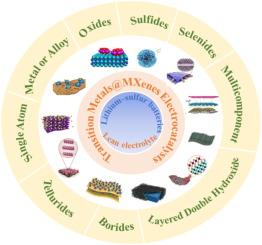Transition Metals@MXenes electrocatalysts for high-performance Lithium–Sulfur batteries under lean electrolyte: A comprehensive review
IF 13.3
1区 工程技术
Q1 ENGINEERING, CHEMICAL
引用次数: 0
Abstract
Lithium–sulfur batteries (LSBs) with various advantages including high energy density, low costs and environmental friendliness, have been considered as one of the most promising advanced rechargeable batteries. Although great achievements have been realized in recent years, these test conditions are generally carried out under excess electrolyte (electrolyte-to-sulfur (E/S) ratio > 10.0 µL mg−1), significantly hindering practical energy density improvements of LSBs. The lean electrolyte is a key factor for improving the energy density of LSBs, yet several tough issues under lean electrolyte, such as shuttle effect, sluggish reaction kinetics and side reaction, seriously hinder the improvement of battery performances. Transition metals@MXenes have been considered as ideal electrocatalysts for regulating redox reaction of LSBs due to their metallic conductivity, large polar surface and abundant active sites. Nevertheless, a in-depth overview of transition metals@MXenes electrocatalysts for lean electrolyte LSBs is still lacking. This review aims to fill this gap by providing a detailed analysis of the mechanisms, challenges, and solutions associated with lean electrolyte LSBs. It focuses on the role of transition metals@MXenes in regulating redox reactions and improving lithium plating/stripping behaviors, particularly in high-concentration lithium polysulfide (LiPS) environments. The review also discusses the structure–activity relationship of these electrocatalysts, highlighting their potential to mitigate the shuttle effect and enhance reaction kinetics. Furthermore, the review presents the latest advancements in the application of transition metals@MXenes for high-performance lean electrolyte LSBs and proposes future research directions to advance their development in the energy storage field.

求助全文
约1分钟内获得全文
求助全文
来源期刊

Chemical Engineering Journal
工程技术-工程:化工
CiteScore
21.70
自引率
9.30%
发文量
6781
审稿时长
2.4 months
期刊介绍:
The Chemical Engineering Journal is an international research journal that invites contributions of original and novel fundamental research. It aims to provide an international platform for presenting original fundamental research, interpretative reviews, and discussions on new developments in chemical engineering. The journal welcomes papers that describe novel theory and its practical application, as well as those that demonstrate the transfer of techniques from other disciplines. It also welcomes reports on carefully conducted experimental work that is soundly interpreted. The main focus of the journal is on original and rigorous research results that have broad significance. The Catalysis section within the Chemical Engineering Journal focuses specifically on Experimental and Theoretical studies in the fields of heterogeneous catalysis, molecular catalysis, and biocatalysis. These studies have industrial impact on various sectors such as chemicals, energy, materials, foods, healthcare, and environmental protection.
 求助内容:
求助内容: 应助结果提醒方式:
应助结果提醒方式:


